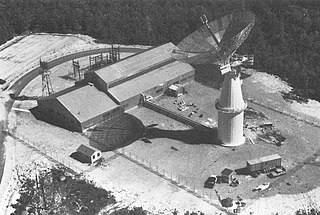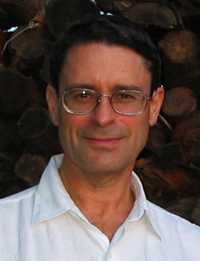The Torino scale is a method for categorizing the impact hazard associated with near-Earth objects (NEOs) such as asteroids and comets. It is intended as a communication tool for astronomers and the public to assess the seriousness of collision predictions, by combining probability statistics and known kinetic damage potentials into a single threat value. The Palermo Technical Impact Hazard Scale is a similar, but more complex scale.
2029 (MMXXIX) will be a common year starting on Monday of the Gregorian calendar, the 2029th year of the Common Era (CE) and Anno Domini (AD) designations, the 29th year of the 3rd millennium and the 21st century, and the 10th and last year of the 2020s decade.
The Palermo Technical Impact Hazard Scale is a logarithmic scale used by astronomers to rate the potential hazard of impact of a near-Earth object (NEO). It combines two types of data—probability of impact and estimated kinetic yield—into a single "hazard" value. A rating of 0 means the hazard is equivalent to the background hazard. A rating of +2 would indicate the hazard is 100 times as great as a random background event. Scale values less than −2 reflect events for which there are no likely consequences, while Palermo Scale values between −2 and 0 indicate situations that merit careful monitoring. A similar but less complex scale is the Torino Scale, which is used for simpler descriptions in the non-scientific media.

Radar astronomy is a technique of observing nearby astronomical objects by reflecting radio waves or microwaves off target objects and analyzing their reflections. Radar astronomy differs from radio astronomy in that the latter is a passive observation and the former an active one. Radar systems have been conducted for six decades applied to a wide range of Solar System studies. The radar transmission may either be pulsed or continuous. The strength of the radar return signal is proportional to the inverse fourth-power of the distance. Upgraded facilities, increased transceiver power, and improved apparatus have increased observational opportunities.

Steven Jeffrey Ostro was an American scientist specializing in radar astronomy. He worked at NASA's Jet Propulsion Laboratory. Ostro led radar observations of numerous asteroids, as well as the moons of Jupiter and Saturn, Saturn's rings, and Mars and its satellites. As of May 2008, Ostro and his collaborators had detected 222 near-Earth asteroids and 118 main belt objects with radar.
(433953) 1997 XR2 is a sub-kilometer sized asteroid, classified as near-Earth object and potentially hazardous asteroid of the Apollo group. It was discovered on 4 December 1997, by the Lincoln Near-Earth Asteroid Research (LINEAR) program at Lincoln Laboratory's Experimental Test Site near Socorro, New Mexico, in the United States.
David James Tholen is an American astronomer at the Institute for Astronomy of the University of Hawaiʻi. He holds a 1984 PhD from the University of Arizona, and specializes in planetary and Solar System astronomy. He is a discoverer of minor planets and known for the Tholen spectral classification scheme used on asteroids.

2000 SG344 is a small Aten asteroid first observed in 2000. It is assumed to have a diameter of approximately 37 meters (120 feet) – or roughly twice that of the Chelyabinsk meteor – and an assumed mass of 7.1×107 kg (71,000 tonnes), but the size is only known within about a factor 2. It is the largest object known to have a better than 1/1000 chance (0.1%) of impacting Earth and has the fourth highest cumulative Palermo rating at −2.79. The next good chance to observe the object will be in May 2028 when it passes 0.02 AU (3,000,000 km; 1,900,000 mi) from Earth.
99942 Apophis (provisional designation 2004 MN4) is a near-Earth asteroid and a potentially hazardous object with a diameter of 370 metres (1,210 feet) that caused a brief period of concern in December 2004 when initial observations indicated a probability up to 2.7% that it would hit Earth on April 13, 2029. Additional observations provided improved predictions that eliminated the possibility of an impact on Earth in 2029. Until 2006, a small possibility nevertheless remained that, during its 2029 close encounter with Earth, Apophis would pass through a gravitational keyhole of no more than about 800 kilometres (500 mi) in diameter, which would have set up a future impact exactly seven years later on April 13, 2036. This possibility kept it at Level 1 on the Torino impact hazard scale until August 2006, when the probability that Apophis would pass through the keyhole was determined to be very small and Apophis's rating on the Torino scale was lowered to zero. By 2008, the keyhole had been determined to be less than 1 km wide. During the short time when it had been of greatest concern, Apophis set the record for highest rating ever on the Torino scale, reaching level 4 on December 27, 2004.
Don Quijote is a past space mission concept that has been studied from 2005 until 2007 by the European Space Agency, and which would investigate the effects of crashing a spacecraft into an asteroid to test whether a spacecraft could successfully deflect an asteroid on a collision course with Earth. The orbiter was designed to last for seven years. The mission did not proceed beyond initial studies.
(144898) 2004 VD17 (provisional designation 2004 VD17) is a sub-kilometer asteroid, classified as near-Earth object of the Apollo group once thought to have a low probability of impacting Earth on 4 May 2102. It reached a Torino Scale rating of 2 and a Palermo Technical Impact Hazard Scale rating of -0.25. With an observation arc of 17 years it is known that closest Earth approach will occur two days earlier on 2 May 2102 at a distance of about 5.5 million km.

2007 VK184 is a sub-kilometer asteroid, classified as a near-Earth object of the Apollo group, and estimated to be approximately 130 meters (430 ft) in diameter. It was listed on the Sentry Risk Table with a Torino Scale rating of 1 for a potential impactor in June 2048. It was removed from the Sentry Risk Table on 28 March 2014.
2007 WD5 is an Apollo asteroid some 50 m (160 ft) in diameter and a Mars-crosser asteroid first observed on 20 November 2007, by Andrea Boattini of the Catalina Sky Survey. Early observations of 2007 WD5 caused excitement amongst the scientific community when it was estimated as having as high as a 1 in 25 chance of colliding with Mars on 30 January 2008. However, by 9 January 2008, additional observations allowed NASA's Near Earth Object Program (NEOP) to reduce the uncertainty region resulting in only a 1-in-10,000 chance of impact. 2007 WD5 most likely passed Mars at a distance of 6.5 Mars radii. Due to this relatively small distance and the uncertainty level of the prior observations, the gravitational effects of Mars on its trajectory are unknown and, according to Steven Chesley of NASA's Jet Propulsion Laboratory Near-Earth Object program, 2007 WD5 is currently considered 'lost' (see lost asteroids).

Minimum orbit intersection distance (MOID) is a measure used in astronomy to assess potential close approaches and collision risks between astronomical objects. It is defined as the distance between the closest points of the osculating orbits of two bodies. Of greatest interest is the risk of a collision with Earth. Earth MOID is often listed on comet and asteroid databases such as the JPL Small-Body Database. MOID values are also defined with respect to other bodies as well: Jupiter MOID, Venus MOID and so on.

OSIRIS-REx was a NASA asteroid-study and sample-return mission that visited and collected samples from 101955 Bennu, a carbonaceous near-Earth asteroid. The material, returned in September 2023, is expected to enable scientists to learn more about the formation and evolution of the Solar System, its initial stages of planet formation, and the source of organic compounds that led to the formation of life on Earth. Following the completion of the primary OSIRIS-REx mission, the spacecraft is planned to conduct a flyby of asteroid 99942 Apophis, now as OSIRIS-APEX.
(85640) 1998 OX4 (provisional designation 1998 OX4) is a sub-kilometer asteroid, classified as near-Earth object and potentially hazardous asteroid of the Apollo group.





